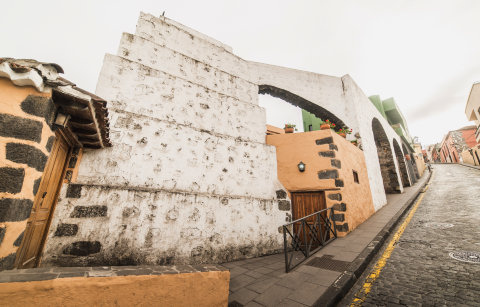11. Gofio mills

There has been a gofio mill on this site since the 16th century. It’s been an uninterrupted business ever since then, so the building has undergone numerous restorations over the centuries. The oldest parts that you can observe date from the end of the 18th century.
Gofio is a roasted cereal flour that was the staple food of the Canaries from before the conquest until the mid-20th century. The Canarian natives, or Guanches, based their diet on gofio, which they made from wheat and barley, and would grind them together manually using two large circular stones. Guanches continued to eat it after the conquest and passed down its use to this day. Although today the consumption of cereals has diversified and bread has gained ground, gofio is still present in the Canary Island diet, and there are mills like this that are still open as small shops.
Along this stretch of street, you can find part of the so-called “Water Route”, which is made up of thirteen original mills. Ten are now preserved, built along the water channel that went down this street, of which only part of the sections made in stone are conserved.
There have been mills in La Orotava since the 16th century. If you look, you’ll see the basic elements necessary for the water to turn the grinding wheel. You can see the ditch supported on the arches through which the water reached the bucket. This bucket was used to store the water that entered from the ditch and connected at its base with the house where the grinding stones were located. These stones were driven by pressurised water that came out of a small duct from the bucket and would grind the cereal. Nowadays, water is channelled under the street and the grinding stones are activated by electricity, which was brought to homes in the town in the 1960s.
The inhabitants of La Orotava brought the cereal grown by themselves to the mill to roast and grind it. The miller’s trade was considered a vile one, as were the trades of butcher and undertaker. Accusations of theft, as well as disputes with millers, were very common. Until the 17th century, this trade was relegated to the most marginalised people in society, such as mixed-race “mestizos” and ex-convicts.
The mills were operational 24 hours a day. They only stopped grinding if any of their components had to be repaired.
Let’s continue. One last push up the street. Go up another 200 metres and you’ll reach Calle Marqués, the highest point of the route. If you look along the way, you’ll find remains of other old mills. Their structures still stand, even though they are not operational.
